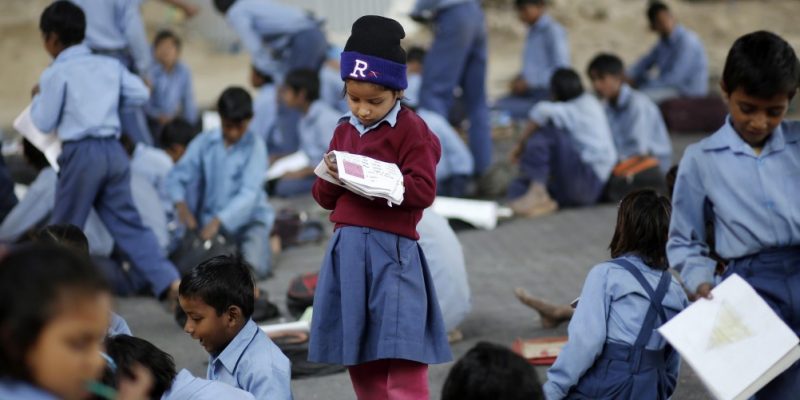The last few days have finally seen a flurry of activities by the Ministry of Human Resource Development (HRD) and various regulators including CBSE, NCERT etc. to find alternatives to ensure the continuation of education. While this may not be a good time to address the seriously low expenditure on education in India, the lack of seriousness towards the sector can be gauged from the fact that HRD was kept in Category C (the lowest category) for expenditure – i.e. the said department will have to restrict expenditure to within 15% of that budgeted for Q1, 2020-21.
Amidst this background, the department and regulators have started moving towards developing an online mode of education – as, hopefully, a stop-gap arrangement. NCERT has released an Alternative Academic Calendar for four weeks of home-based activities for different subjects. For example, activities like categorising objects including eraser, pencils, cloth, pulses etc. to teach the concepts of colours, shapes and sizes have been suggested for the students of Class I-IV.
For Class V students, teachers will be conducting classes through internet-based platforms, in the absence of which SMS and voice recordings can be sent. However, it has not been explained how voice recordings can be sent without the internet. Certain states including Uttar Pradesh are planning to launch high-quality ed-tech applications along with using e-resources suggested by the MHRD including e-pathshala etc.
However, amongst this whole discourse of moving education online, there has hardly been any discussion surrounding the practical issues of implementation, as well as various socio-economic factors which define the Indian education ecosystem.
Limited internet availability
The 75th report of the National Sample Survey Office (NSSO) for 2017-18 highlights some of the major issues that this new model would have to address. All India percentage of households having internet facilities stands at 23.8% with rural availability at 14.9% and urban at 42%.
Also read: Rethinking Education in the Age of the Coronavirus
The problem does not end there, as having a facility does not mean it would be used. The percentage of people who were able to use the internet (all-India) stood at 20.1% with rural at 13% and urban at 37.1%. Additionally, only 10.8% of people in India had used the internet in the last 30 days. It is important to note that these statistics vary vastly among different states across the country. For instance, Bihar stands at the lowest (9.1%) for individuals who have used the internet in 30 days, while Delhi has the highest number (49.1%) of such individuals with bigger states like Maharashtra (26%), Rajasthan (15.3%), Andhra Pradesh (14.8%) etc. being in the middle.
These statistics strike at the core rationale of using the internet as a mode to impart education, and highlight how a majority of the country would be left out of the quest to achieve basic education in the months to come.
Increased responsibility of parents to educate their wards
Another important pillar of the new model is the increased role that parents play in educating their wards. Take, for example, the NCERT guidelines which – surprisingly has progressive methods of teaching to improve the analytical, quantitative, and logical reasoning abilities of the students – all key factors which our regular model of teaching and learning does not have. However, the guidelines presume that the parents will have the academic intellect to impart education to their students. But statistics highlight otherwise.
The same NSSO survey, quoted above, highlights that 26.1% of the population above 15 years of age is ‘not literate’, while a further 18.9% have attended formal education up till primary school, 16.2% each have attended middle (Class V) and secondary (until Class VIII). This constitutes a whopping 77.4% of total India’s population – who may not have the adequate level of education needed to teach children in the house. The situation at the rural level is even more dire, with 69.6 % of the population being in the spectrum of ‘not-literate’ to ‘middle school’.
Loss of nutrition due to school closure
While the above factors touched upon the modality of the education, there is an even more basic issue at stake. The closure of schools has serious implications on the daily nutrition of students as the mid-day meal schemes have temporarily been shut. As of March 31, 2019, close to 12 crore students across the country were provided with food under with mid-day meal schemes.

Guardians of students stand in queues to collect mid-day meal at a school during a nationwide lockdown imposed to curb the spread of novel coronavirus, in Murshidabad district, Monday, April 20, 2020. Photo: PTI
This is close to 60% of the total students enrolled throughout K-12 education (the actual percentage is likely to be more, as mid-day meal only caters to students till Class VIII). Various studies have pointed out that mid-day meals are an important contributing factor for increased enrolment (~30%) in the schools.
Also read: A Viral Education? Into the Future of Our Locked Classrooms and Shut Campuses
These factors highlight a very dangerous scenario for the K-12 education sector in our country. Our learning outcomes in K-12 education do not inspire much confidence, in the first place, as has been pointed out repeatedly in various ASER reports by Pratham.
The loss of possibly half a year – if not the full academic year of 2020-21 – is going to further deteriorate the situation, as students would have difficulty in resuming schooling again after a huge gap. Additionally, the loss of income for a considerable population in India is going to further exacerbate the situation – CMIE’s data suggests that 11.9 crore people have lost employment in the two weeks of the COVID-19 lockdown. Investment in education is not going to be a priority, amongst disadvantaged households, and we might see a dip in enrolment, when and if, schools are opened.
Possible solutions
While the damage to the sector is similar to the damage every sector across the world is facing, it is possible that with some careful planning, we might be able to limit the long-term consequences of this prolonged shutdown.
To begin with, the districts in the green zone should be allowed to open schools – after analysing them further over the next few days. So far, there are 318 districts such in the country – which will likely cover a majority of the school children. Eventually, 292 yellow zone districts – which may turn to the green zone in the next few days or weeks – should also allow schools to open.
Strict social distancing measures should be implemented, and to limit the number of students, classes may run in two four-hour shifts. While this strategy would not result in finishing the quarterly curriculum, this will at least reduce the gap in learning that students are likely to experience if schools continue to remain shut for long. This may also help in addressing the possible increase in drop-outs due to the long shutdown.
This leaves the government with 107 districts which are in red and orange zones. It might not be possible to open schools in these areas any time soon, thus, there is a need to deploy public funds to fix the internet gap and ensure that students continue to learn. Some state government have come up with ideas to address this concern.
The Delhi government had mooted an interesting idea to provide data packages to the students of Class X and XII. While this is likely to have certain implementation challenges – particularly the misuse of data for objectives other than learning – smart technology solutions can be found. Use of the internet can be restricted to specific applications prepared by the government. Similarly, another interesting idea has been in works in the state of Uttar Pradesh which is planning to use Doordarshan, All India Radio and community radio to promote audio-based learning among students who do not have access to the internet.
Also read: Teaching in the Time of Isolation
Additionally, there is a need to develop a financial stimulus for the education sector primarily targeting low cost private aided and unaided schools – which are likely to witness a reduction in fee collections, due to income losses. Various states, including Rajasthan, Punjab, Haryana, and Uttar Pradesh have already announced that schools should not pressurise parents to pay fees.
However, a move like this is going to have a spillover impact on the incomes of teachers at such low-cost private schools. As of 2016-17, close to 28 lakh teachers were employed in private unaided schools, and further 8.3 lakh in government-aided schools. A more rational system could be to allow a reduced percentage of the fee in schools which are partially working (red and orange zone), with full fees for schools which would be fully functional (green and yellow).
Wherever relevant, a grant-in-aid could be issued for specific schools on a case-to-case basis to bridge income and expenditure. The powers for the same can be devolved to the district authorities to ensure a more localised approach.
While understandably, India as a developing country does not have unlimited resources, certain core sectors including education cannot simply be left as the last priority. Similar to other sectors, which are witnessing a staggered opening, the education sector – particularly the K-12 education system – needs to be opened in a staggered way.
These 12 years of education are crucial for every student and are the base years that will support the upward social and economic mobility of disadvantaged classes. A long and unplanned hiatus is likely to shatter the dreams of many and further harm the country in the long-term with a less-educated workforce. We need more talented and skilled individuals to get us out of the possible recession that the world is going to face and dropping the ball on education, is not going to help the cause.
Rohit Kumar is a government and regulatory affairs professional based out of Delhi. He works in driving public policy and advocacy campaigns across various sectors in India. He is also a former LAMP fellow. He tweets at @rsachdeva735



